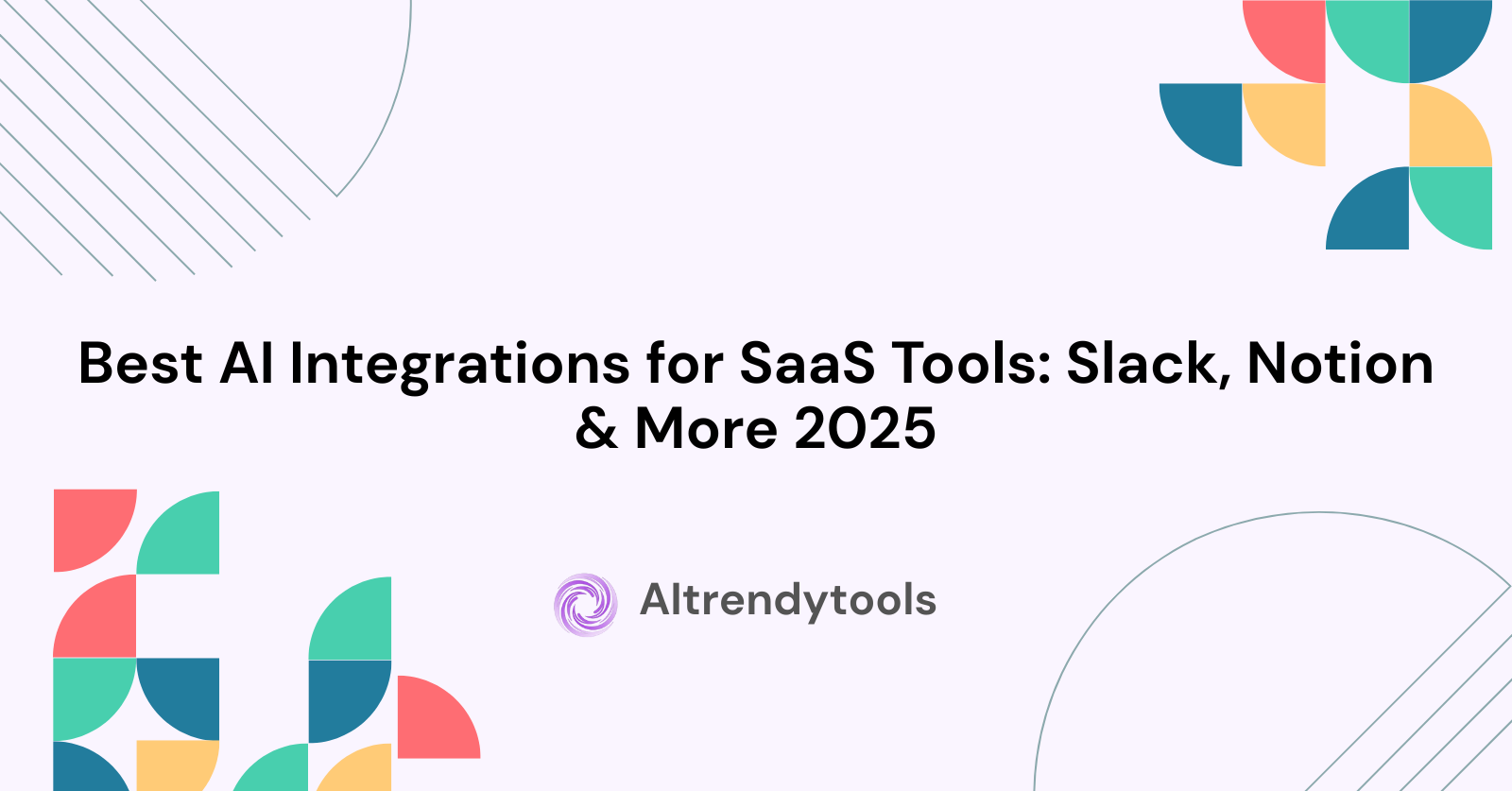🔥 AITrendytools: The Fastest-Growing AI Platform |
Write for usBest AI Integrations for SaaS Tools: Slack, Notion & More 2025
Discover the top AI integrations transforming workplace SaaS tools. From Slack automation to Notion AI features - boost productivity today.
Sep 18, 2025
AI integrations are transforming workplace SaaS tools at an unprecedented pace, revolutionizing how teams collaborate, communicate, and manage projects. Modern businesses rely heavily on cloud-based software solutions to streamline operations and boost productivity. The integration of artificial intelligence into these platforms creates powerful synergies that automate routine tasks and enhance decision-making processes.
Workplace productivity tools like Slack, Notion, Asana, and Microsoft Teams now incorporate sophisticated AI capabilities that were once exclusive to specialized software. These integrations eliminate manual processes, reduce human error, and provide intelligent insights that drive better business outcomes. The convergence of AI and SaaS represents a fundamental shift in how organizations approach workflow optimization.
This comprehensive guide explores the most impactful AI integrations currently available for popular workplace SaaS platforms. We'll examine specific features, implementation strategies, and real-world benefits that these integrations deliver to modern teams. Understanding these capabilities helps businesses make informed decisions about technology adoption and workflow enhancement strategies.
Slack AI Features Revolutionizing Team Communication
Slack has emerged as a pioneer in workplace AI integration, introducing features that fundamentally change how teams communicate and collaborate. The platform's AI capabilities extend far beyond simple chatbots, offering sophisticated automation and intelligence that streamlines daily operations.
Slack's Workflow Builder now incorporates AI-powered decision trees that can automatically route messages, assign tasks, and trigger actions based on message content and context. These intelligent workflows reduce manual intervention while ensuring important communications reach the right team members at optimal times.
The platform's search functionality has been enhanced with natural language processing, allowing users to find information using conversational queries rather than specific keywords. This improvement significantly reduces time spent searching for files, messages, or project updates across multiple channels and workspaces.
Key Slack AI Capabilities:
- Automated message summarization for catching up on missed conversations
- Intelligent notification filtering to reduce noise and highlight priority messages
- AI-powered thread suggestions that connect related discussions automatically
- Smart scheduling assistants that coordinate meetings across time zones
- Contextual file recommendations based on conversation topics
- Automated status updates that sync with calendar events and project milestones
Canvas integration with AI allows teams to create dynamic documents that automatically update based on channel activities and project progress. These living documents serve as centralized information hubs that evolve with ongoing work.
Thread summarization helps team members quickly understand lengthy discussions without reading every message. The AI analyzes conversation flow and highlights key decisions, action items, and important information for efficient catch-up sessions.
Notion AI Integration Transforming Document Management
Notion's AI integration represents a significant advancement in how teams create, organize, and manage information within collaborative workspaces. The platform combines traditional document creation with intelligent automation that adapts to user behavior and content patterns.
AI-powered writing assistance helps users generate content, improve existing text, and maintain consistent tone across different document types. The system learns from organizational writing styles and suggests improvements that align with company communication standards and brand voice.
Database automation uses AI to categorize entries, suggest tags, and identify relationships between different pieces of information. This intelligent organization reduces manual data entry while improving searchability and content discoverability across large knowledge bases.
Template suggestions leverage machine learning to recommend document structures based on content type, team function, and project requirements. These recommendations accelerate document creation while ensuring consistency across team outputs and organizational standards.
Notion AI Features:
- Content generation for meeting notes, project briefs, and documentation
- Automatic table of contents creation for long-form documents
- Intelligent task extraction from meeting notes and project discussions
- Smart property suggestions for database optimization
- Contextual content recommendations based on related pages and projects
- Automated formatting and style consistency across documents
Real-time collaboration enhancements use AI to predict merge conflicts, suggest edit sequences, and optimize simultaneous editing experiences. These features reduce friction when multiple team members work on shared documents concurrently.
Knowledge graph creation automatically maps relationships between pages, projects, and team members, creating visual representations of organizational knowledge and workflow connections that improve navigation and discovery.
Microsoft Teams AI Capabilities Enhancing Virtual Collaboration
Microsoft Teams leverages advanced AI capabilities to create more intelligent and productive virtual collaboration experiences. The platform integrates with Microsoft's broader AI ecosystem, including Copilot, to deliver sophisticated automation and assistance features.
Meeting intelligence captures and analyzes conversation patterns, participant engagement, and discussion topics to provide actionable insights for improving team dynamics and meeting effectiveness. These analytics help managers optimize team performance and identify collaboration bottlenecks.
Automatic transcription and translation services enable global teams to collaborate effectively across language barriers. Real-time translation supports over 60 languages, while transcription accuracy continues improving through machine learning algorithms that adapt to different accents and speaking patterns.
Background noise suppression and voice enhancement use AI to improve audio quality during calls and meetings. These features automatically filter out distracting sounds while amplifying important speech, creating more professional and focused virtual meeting environments.
Teams AI Integration Benefits:
- Live captions and translations for inclusive meetings
- Intelligent meeting scheduling that considers all participants' availability
- Automated action item extraction from meeting discussions
- Smart content sharing recommendations based on conversation context
- AI-powered breakout room assignment for optimal collaboration
- Predictive text suggestions for faster message composition
Copilot integration brings advanced AI assistance directly into Teams workflows, helping users draft messages, summarize conversations, and generate meeting agendas. This integration creates seamless transitions between different Microsoft 365 applications while maintaining context and continuity.
Attendance tracking and engagement analytics provide insights into meeting participation patterns, helping organizers identify optimal meeting times, formats, and structures for different team configurations and project types.
Asana AI Automation Streamlining Project Management
Asana's AI integration focuses on intelligent project management automation that reduces administrative overhead while improving project visibility and team coordination. The platform uses machine learning to identify patterns in project execution and suggest optimizations for future initiatives.
Smart task assignment analyzes team workloads, skill sets, and availability to recommend optimal task distribution. This feature helps project managers balance team capacity while ensuring tasks are assigned to the most qualified team members.
Progress prediction algorithms estimate project completion times based on historical data, current progress rates, and resource availability. These predictions help teams set realistic deadlines and identify potential bottlenecks before they impact project delivery.
Automatic dependency mapping identifies relationships between tasks and projects, creating visual workflows that highlight critical paths and potential scheduling conflicts. This automation reduces manual project planning time while improving accuracy and completeness.
Asana AI Features:
- Intelligent deadline suggestions based on task complexity and team capacity
- Automated status report generation for stakeholder communications
- Risk assessment algorithms that flag potential project delays
- Resource optimization recommendations for balanced team workloads
- Smart goal tracking with progress milestone identification
- Contextual task suggestions based on project type and team history
Template intelligence suggests project structures and task lists based on similar successful projects within the organization. This feature accelerates project setup while incorporating proven methodologies and best practices.
Workflow automation creates intelligent rules that trigger actions based on project events, status changes, and deadline approaches. These automations ensure consistent project management practices while reducing manual oversight requirements.
AI-Powered Collaboration Tools Transforming Remote Work
Remote work environments benefit significantly from AI-powered collaboration tools that bridge physical distance gaps and create more connected virtual work experiences. These tools leverage artificial intelligence to maintain team cohesion and productivity regardless of geographic distribution.
Virtual presence indicators use AI to analyze activity patterns and availability signals, providing team members with better awareness of colleague availability and optimal communication timing. These systems go beyond simple status indicators to provide context about work focus and interruption appropriateness.
Automated meeting coordination considers time zones, calendar conflicts, and participant preferences to suggest optimal meeting times and formats. AI scheduling assistants can negotiate complex multi-participant schedules while respecting individual time zone preferences and working hour constraints.
Content synchronization ensures that team members have access to the most current information regardless of when they access shared resources. AI systems track document versions, update notifications, and change summaries to keep distributed teams aligned on project progress.
Remote Collaboration AI Benefits:
- Intelligent workspace organization that adapts to team usage patterns
- Automated timezone conversion and scheduling optimization
- Smart notification timing based on individual productivity patterns
- AI-powered onboarding assistance for new remote team members
- Contextual help and guidance based on user behavior and needs
- Predictive bandwidth optimization for video calls and file sharing
Communication pattern analysis helps teams understand collaboration effectiveness and identify opportunities for improving remote work dynamics. These insights guide decisions about meeting frequency, communication channels, and collaboration tool usage.
Digital whiteboard AI enhances brainstorming sessions with intelligent shape recognition, text extraction, and idea organization. These features make virtual collaboration sessions more productive and engaging for distributed teams.
SaaS Productivity Tools with Smart AI Features
Modern SaaS productivity tools incorporate AI features that learn from user behavior and adapt to organizational needs. These intelligent systems create personalized experiences that improve efficiency while reducing cognitive load associated with routine tasks.
Calendar AI manages scheduling complexity by analyzing meeting patterns, participant preferences, and optimal timing for different types of interactions. Smart calendars can automatically block focus time, suggest meeting alternatives, and optimize daily schedules for maximum productivity.
Email intelligence filters, prioritizes, and suggests responses to reduce inbox management time. AI systems learn individual communication patterns and can draft contextually appropriate responses, schedule follow-ups, and identify high-priority messages requiring immediate attention.
Document intelligence extracts key information from various file types, creating searchable metadata and automatic categorization systems. This capability improves information retrieval while reducing time spent organizing and filing digital documents.
Smart Productivity Features:
- Predictive text and auto-completion for faster content creation
- Intelligent file organization based on content analysis and usage patterns
- Automated expense tracking and categorization for financial management
- Smart form filling using previously entered information and context clues
- AI-powered data validation and error detection in spreadsheets and databases
- Contextual app suggestions based on current tasks and time of day
Task prioritization algorithms analyze deadlines, dependencies, and importance levels to suggest optimal work sequences. These systems help users focus on high-impact activities while ensuring nothing important falls through the cracks.
Resource recommendation engines suggest relevant tools, templates, and information based on current projects and past usage patterns. This contextual assistance accelerates task completion while introducing users to helpful features they might otherwise overlook.
Platforms like those featured on aitrendytools.com showcase the latest AI-powered productivity solutions that are transforming how teams approach daily work challenges and long-term project management.
Workplace Automation Tools Powered by Artificial Intelligence
Workplace automation tools powered by AI eliminate repetitive tasks while ensuring accuracy and consistency across business processes. These systems learn from human actions and gradually take over routine operations, freeing teams to focus on strategic and creative work.
Data entry automation uses optical character recognition and natural language processing to extract information from documents, emails, and forms. This capability reduces manual data input while improving accuracy and speed of information processing across various business functions.
Approval workflow automation routes requests through appropriate channels based on content analysis, dollar amounts, and organizational hierarchy. AI systems can make routine approval decisions while escalating complex cases to human reviewers, streamlining bureaucratic processes.
Report generation automation creates regular business reports by gathering data from multiple sources, analyzing trends, and formatting information according to predefined templates. This automation ensures consistent reporting while saving significant time on routine analysis tasks.
Automation Implementation Benefits:
- Reduced human error in repetitive tasks and data processing
- Faster processing times for routine business operations
- Consistent application of business rules and policies
- Improved audit trails and compliance documentation
- Enhanced scalability for growing business operations
- Cost reduction through decreased manual labor requirements
Customer service automation handles routine inquiries and support requests using intelligent chatbots and decision trees. These systems can resolve common issues instantly while routing complex problems to appropriate human agents with relevant context and history.
Inventory management automation predicts stock needs, monitors supply levels, and generates purchase orders based on usage patterns and seasonal trends. AI systems optimize inventory levels while minimizing carrying costs and stockout risks.
AI Chatbots for Business Communication
Business AI chatbots have evolved beyond simple question-and-answer systems to become sophisticated communication partners that understand context, maintain conversation history, and provide personalized assistance based on user roles and needs.
Customer support chatbots handle increasingly complex inquiries using natural language understanding and access to comprehensive knowledge bases. These systems can troubleshoot technical issues, process returns, and provide product information with accuracy that rivals human agents.
Internal communication bots help employees find information, complete routine tasks, and navigate organizational processes. These assistants can answer HR questions, help with IT support requests, and provide guidance on company policies and procedures.
Sales automation chatbots qualify leads, schedule demonstrations, and provide product information to potential customers. These systems work around the clock to capture and nurture leads while freeing sales teams to focus on closing deals and building relationships.
Chatbot Integration Advantages:
- 24/7 availability for customer support and internal assistance
- Consistent response quality regardless of volume or timing
- Multilingual support for global business operations
- Integration with existing business systems and databases
- Detailed analytics on common questions and interaction patterns
- Scalable solution that grows with business needs
Training and onboarding chatbots guide new employees through orientation processes, answer common questions, and provide personalized learning paths based on role requirements and individual progress.
Marketing chatbots engage website visitors, qualify prospects, and deliver targeted content based on user behavior and interests. These systems can guide visitors through product selection while collecting valuable data for future marketing efforts.
Enterprise AI Solutions for Large Organizations
Enterprise AI solutions address the complex needs of large organizations with sophisticated integration requirements, advanced security features, and scalable architectures that support thousands of users across multiple departments and locations.
Centralized AI governance platforms manage AI model deployment, monitor performance metrics, and ensure compliance with regulatory requirements. These systems provide oversight and control necessary for responsible AI implementation in enterprise environments.
Cross-platform integration enables AI capabilities to work seamlessly across different SaaS tools and legacy systems. Enterprise solutions often require custom APIs and middleware to connect disparate systems while maintaining data security and user experience consistency.
Advanced analytics platforms use AI to process vast amounts of organizational data, identifying trends, predicting outcomes, and providing strategic insights for executive decision-making. These systems can analyze everything from employee performance to market conditions.
Enterprise AI Considerations:
- Robust security frameworks protecting sensitive business data
- Compliance with industry regulations and data protection laws
- Scalability to support large user bases and high transaction volumes
- Integration capabilities with existing enterprise software ecosystems
- Customization options for industry-specific requirements
- Professional support and service level agreements
Change management AI helps organizations navigate technology adoption by analyzing user behavior, predicting resistance patterns, and suggesting optimal rollout strategies for new tools and processes.
Performance monitoring AI tracks system usage, identifies optimization opportunities, and predicts maintenance needs across complex enterprise technology stacks. This proactive approach minimizes downtime while maximizing return on technology investments.
Resources available through aitrendytools.com provide enterprises with comprehensive reviews and comparisons of AI solutions designed for large-scale organizational implementation.
Implementation Strategies for AI-Powered SaaS Integration
Successful AI integration requires strategic planning, careful tool selection, and thoughtful change management to ensure adoption success and maximum business value. Organizations must consider their current technology stack, team capabilities, and business objectives when implementing AI-powered solutions.
Pilot program development allows organizations to test AI capabilities on a small scale before full deployment. These controlled implementations provide valuable insights into user adoption patterns, technical requirements, and business impact measurements.
Training and education programs ensure team members understand AI capabilities and know how to leverage new features effectively. Comprehensive training reduces resistance to change while accelerating time-to-value for AI investments.
Integration planning addresses technical requirements, data security considerations, and workflow modifications necessary for successful AI implementation. Careful planning prevents disruptions while ensuring smooth transitions to enhanced productivity tools.
Implementation Best Practices:
- Start with high-impact, low-complexity use cases to demonstrate value
- Involve end users in tool selection and customization processes
- Establish clear success metrics and measurement frameworks
- Provide ongoing support and feedback channels for continuous improvement
- Plan for scalability and future feature expansion
- Monitor adoption rates and adjust training approaches as needed
Data preparation ensures that AI systems have access to clean, relevant information necessary for optimal performance. Organizations often need to standardize data formats and improve data quality before AI implementation.
Performance monitoring tracks AI system effectiveness, user adoption rates, and business impact metrics. Regular assessment helps organizations optimize their AI investments while identifying opportunities for expansion or improvement.
Measuring ROI from AI Workplace Integrations
Measuring return on investment from AI workplace integrations requires comprehensive metrics that capture both quantitative benefits and qualitative improvements in team productivity and satisfaction. Organizations need clear measurement frameworks to justify AI investments and guide future technology decisions.
Time savings calculations measure the reduction in manual work hours achieved through AI automation. These measurements should include both direct time savings and indirect benefits from improved accuracy and reduced rework requirements.
Productivity metrics track improvements in task completion rates, project delivery times, and overall team output. AI integrations often enable teams to accomplish more work in less time while maintaining or improving quality standards.
Cost reduction analysis examines savings from reduced manual labor, decreased error rates, and improved resource utilization. These calculations should include both direct cost savings and avoided costs from prevented mistakes and delays.
ROI Measurement Framework:
- Baseline measurements before AI implementation for comparison purposes
- Regular tracking of key performance indicators and productivity metrics
- User satisfaction surveys to capture qualitative benefits and challenges
- Cost analysis including implementation, training, and ongoing subscription expenses
- Business impact assessment measuring improvements in customer satisfaction and revenue
- Long-term trend analysis to understand sustained benefits and optimization opportunities
Quality improvements often result from AI integration, including reduced error rates, more consistent outputs, and enhanced decision-making capabilities. These improvements can be challenging to quantify but significantly impact business outcomes.
Employee satisfaction measurements capture the impact of AI tools on job satisfaction, work-life balance, and professional development opportunities. Positive employee experiences with AI tools often correlate with higher adoption rates and greater business benefits.
Future Trends in AI-Powered SaaS Tools
The future of AI-powered SaaS tools promises even more sophisticated capabilities that will further transform workplace productivity and collaboration. Emerging technologies and evolving user expectations drive continuous innovation in this rapidly advancing field.
Predictive analytics will become more sophisticated, enabling SaaS tools to anticipate user needs and proactively suggest actions, resources, and optimizations. These capabilities will create more intuitive and helpful software experiences that adapt to individual and team patterns.
Natural language interfaces will make complex software features accessible to non-technical users, democratizing advanced capabilities and reducing the learning curve for powerful productivity tools. Voice and conversational interfaces will become standard features across SaaS platforms.
Cross-platform AI coordination will enable different tools to work together more intelligently, sharing context and insights to create seamless workflows that span multiple applications and services. This integration will reduce context switching and improve overall productivity.
Emerging AI Capabilities:
- Augmented reality integration for immersive collaboration experiences
- Advanced personalization that adapts to individual work styles and preferences
- Predictive maintenance for preventing software issues before they impact users
- Emotional intelligence features that consider team dynamics and individual well-being
- Blockchain integration for secure and transparent AI decision-making
- Quantum computing applications for complex optimization and analysis tasks
Ethical AI considerations will become increasingly important as organizations implement more sophisticated AI systems. Transparency, fairness, and accountability will be essential features of future AI-powered workplace tools.
Continuous learning capabilities will enable AI systems to improve automatically based on user feedback and changing business requirements. These adaptive systems will provide increasingly valuable assistance as they learn from organizational patterns and preferences.
Conclusion
AI integrations are fundamentally transforming workplace SaaS tools, creating unprecedented opportunities for productivity enhancement and workflow optimization. From Slack's intelligent communication features to Notion's AI-powered document management, these integrations represent a paradigm shift in how teams collaborate and accomplish work.
The most successful organizations will be those that strategically implement AI-powered tools while focusing on user adoption, training, and continuous optimization. Understanding the capabilities and benefits of different AI integrations helps businesses make informed decisions about technology investments and workflow improvements.
The future of workplace productivity lies in the intelligent integration of AI capabilities across all business tools and processes. Organizations that embrace these technologies thoughtfully and strategically will gain significant competitive advantages through enhanced efficiency, improved decision-making, and more engaged and productive teams.
As AI technology continues advancing, the integration opportunities will only expand, offering even more sophisticated capabilities for workplace enhancement. Staying informed about these developments and maintaining flexibility in technology adoption strategies ensures organizations can capitalize on emerging opportunities while building sustainable competitive advantages.
🚀 Submit Your Tool to Our Comprehensive AI Tools Directory
Get your AI tool featured on our complete directory at AITrendytools and reach thousands of potential users. Select the plan that best fits your needs.





Join 30,000+ Co-Founders
Related Blogs
Dext Review 2025: Guide to Automate Your Bookkeeping
Discover how Dext software transforms expense management with 99.9% accuracy. Complete guide to features, pricing, integrations & alternatives for 2025.
Texto Invisible: 10 Ways to Copy Hidden Text & Blank Space
Master texto invisible for WhatsApp, Instagram & gaming. Learn how to create hidden text, blank characters & empty spaces. Free generator + step by step guide
WriteHuman AI Review: Does It Really Bypass AI Detectors?
Honest WriteHuman AI review with real testing results. Learn if this AI humanizer actually works, pricing details, and better alternatives for 2025.
Submit Your Tool to Our Comprehensive AI Tools Directory
List your AI tool on AItrendytools and reach a growing audience of AI users and founders. Boost visibility and showcase your innovation in a curated directory of 30,000+ AI apps.





Join 30,000+ Co-Founders

